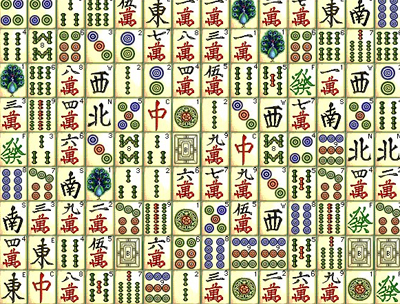
Many Chinese games bear symbols which have a specific meaning in the context of Chinese classical philosophy and cosmology. Often the symbols have merely a decorative function: either the traditional meaning is not known to players or it is not relevant for playing and enjoying the game. This applies much to Mah Jong, as well, though it seems clear that the game was initially developed based on fundamental concepts of Chinese philosophy and cosmology (e.g., concepts of Yin, Yang and Tao), and that these aspects were once significant to players of the game.
The following description, primarily based on writings of Ly Yu Sang (Sparrow,
the Chinese Game called Ma-Chiau, 1923) and A.D.
Millington, explains the underlying symbolism of Mah Jong.
The developers of the classical Mah Jong were educated and knew well the
classical Chinese philosophical and mythological tradition, particularly the
Book of Changes and the Book of Surprises. The elements of the game symbolize
interaction of the three extremes of the universe: Heaven, Earth and Man,
expressed in many ways, not only by images graved in the tiles, but also in a
way the tiles form numerically significant groups and combinations.
Thus 144 is said to be the number of the plan of Earth, and the square formed
by the tiles can be seen as a symbolic representation of the universe. Heaven is manifested
in the Four Seasons, Earth in the Four regions (East, South, West and North),
and Man in the Four Flowers (symbolizing motion or life). The Dragons ('San
Yuan' or 'San Chi' in Chinese, meaning "Extremes") symbolize Heaven
(White Dragon, 'Po', meaning "white" or" blank"), Earth
(Green Dragon, 'Fa', meaning "prosperous") and Man (Red Dragon,
'Chung', meaning "center", i.e. "between Heaven and
Earth").
Furthermore, the suits ('San Lei', "three categories") represent
movements of the three extremes. The Dots (properly termed 'Tung', meaning
"wheels") represent the Wheel of Heaven, the Bamboos (originally
called 'Chou', meaning "axes") signify Axis of of the Earth, and the
Characters (originally called 'Shu', meaning "numbers") represent the
changes of the life of Man.
The goal of Mah Jong is to collect a harmonious combination of elements (the
Chinese actually do not say 'Mah Jong' when they have a complete hand, but 'ho'
or 'fu', the previous meaning "harmony, peace" and the latter meaning
"happiness, blessing, luck"). Symbolically – though not
strategically – the most perfect way of going out is completing the pair (thus
the reward in the classical Mah Jong given for going out on the pair).
Though knowledge of the underlying symbolism helps to understand
better some of the rules and particularly the scoring of the game, and deepens a
player's enjoyment of the beauty and spirit of the game, its meaning should not
be exaggerated. Ordinary Western playing cards (and especially their
predecessors, the Tarot cards) bear similar cosmological
meanings, significations affected by number-mysticism, etc., but an average
player using them for poker or bridge is as unlikely to give any
significance to these symbolic aspects as an average Chinese player playing Mah Jong.
(However, both Western cards and tiles of Mah Jong are widely used for
divination so the symbolic aspects are important in another context.)
Ironically, it can be said that the symbolism is most likely to fascinate the
minds of Western players, who might sense something of the presence of the ancient
oriental wisdom while handling the "mysterious" tiles of Mah Jong. On
the other hand, some Chinese authors, who still emphasize the philosophical
aspects of the game, might interpret the symbolism of Mah Jong in much more
earthly terms, seeing the suits as symbols of food,
shelter and money and Dragons as symbols of a high governmental position, first
prize of a lottery, and longevity…
But in order to not let ourselves become too cynical, it is appropriate to complete this
short overview by citing A.D. Millington, who lays out the spirit and purpose of
the game in the following manner: "[The materials of the tiles] serve to
remind the player of the Confucian virtues which he should possess. – – They
also remind him of the spirit of the game, which no player should ignore, and of
its purpose, which is to develop the mind to search after Truth and to conform
and reconcile itself-serenely, yet not in an attitude of indifference,
resignation or fatalism, to the decrees of Heaven."












Nessun commento:
Posta un commento